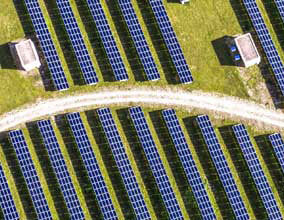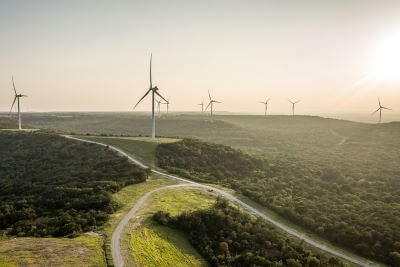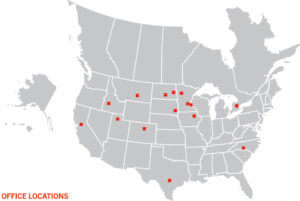Solar Power and BESS Integration in Oil Country

July 13, 2021
Ulteig’s System Integration and SCADA Services Team Integrates Solar Power Plant and Battery Energy Storage System in the Oil Basin of West Texas
Midland, Texas – As oil and gas companies harvest oil and natural gas through wells that go from a few hundred feet to five miles underground, on the surface, a Danish renewable energy company is harvesting the power of the sun.
Make no mistake about it, as far as the eye can see, this is oil country. In this desert country, things are changing as clean energy meets the heart of the fossil fuel industry. The change we speak of, is the arrival of a 460 MW (AC) solar power plant featuring 420 MW of solar PV and a 40 MW battery energy storage system (BESS) located on a 3,600-acre site alongside an existing oil and gas installation. Supplying a growing demand in West Texas for electricity, the project’s 1.3 million solar panels will generate enough clean energy to power more than 80,000 homes.
Providing an Integration Strategy
To help the owner of the new solar energy center integrate the solar PV and BESS with the Texas electrical grid known as ERCOT, the solar plant’s owner called on Ulteig’s System Integration and SCADA Team. For this project, Ulteig served as the Engineer of Record (EOR) for the substation, providing AC and DC collection, site PV, and civil engineering services. This allowed project design leads to collaborate on multiple design elements with the internal client team, optimizing system layouts for construction efficiency and reducing rework during both design and construction of the project.
“They heard about our reputation and experience, especially working through challenging projects.” said Greg Brunke, Director of Energy within Ulteig’s Power and Renewables group, “and our expertise in systems integration and controls.”
Ulteig defines systems integration as the ability to incorporate data and control sub-system equipment from multiple vendors and bring them together into a single unified system that meets the owner’s operational and regulatory needs. The intent of this approach is to optimize the power generation of the system, allowing the owner to maximize their investment, build in resilience to effectively resolve outages and prevent failures, improve the exchange of information from the power plant with centralized control center, and fortify the system in the event of a cyberattack.
This solar project in West Texas can be broken down into two primary elements:
SCADA Integration for the Solar PV – Ulteig’s System Integration and SCADA Team designed a plant controller system for the power plant’s solar PV, which included 1,305,304 modules, 135 inverters and 520MW DC installed.
Battery Energy Storage System Integration – For this project, the owner installed utility-scale batteries with 1 hour of electrical storage. The battery energy storage system (BESS) included: 20 inverters, 360 battery racks, and 5,400 battery modules. This project represents one of the few installations of a BESS with a solar project in Texas within the ERCOT system.
“Coupling battery storage with solar PV was new for our client, and new for Texas,” said McKenzie Santin, Associate Director of Energy within Ulteig’s Power and Renewables group. “We are seeing a growing interest in adding battery storage to solar projects and we anticipate more of these types of projects in the future.”
Overcoming Unique Challenges
A number of challenges emerged with this project. These included:
Placing a Solar Power Plant in the middle of Oil Country — The solar energy center is located within an active area of the West Texas oil basin, which created a number of design challenges related to both oil and gas utility lines as well as capped, active and future well sites. The oil basin is an oil-and-gas-producing area located in West Texas and the adjoining area of southeastern New Mexico. It covers an area of about 250 miles wide by 300 miles long and is composed of more than 7,000 oil and natural gas fields. The greater oil basin produces nearly 40 percent of all oil production in the United States and nearly 15 percent of its natural gas production, according to the Federal Reserve Bank of Dallas.
Size of the project – At 460-MW, the size of the solar energy center is among the largest solar projects in the U.S. The largest currently operating solar farm in the U.S. is the 579-MW Solar Star installation in California, which came online in 2015 and at the time was the largest solar array in the world, according to Power Magazine. A project this large inherently offered its own unique challenges simply based on its size and scope.
Fast Frequency Response (FFR) – The owner of the solar project sought to have the BESS participate in the new FFR ancillary service market. This self-dispatched service requires full output from the BESS within 15 cycles (250 milliseconds) which it must maintain between 95%-105% throughout the dispatch period. FFR is emerging as an in-demand technology to address the lack of inertia from inverter-based resources. The intent behind FFR is to increase system stability by providing high speed frequency support normally handled by traditional generation. Ulteig’s System Integration team was successfully able to design, and commission a site controller that met these requirements.
Relocating Existing Utility Lines — Prior to the start of the project, Ulteig learned it would need to collaborate with both the contractor and the owner to identify which existing utility lines would need to be relocated to develop a PV array layout that would meet final site constraints and setbacks while meeting the plant power requirements. Ulteig’s ability to coordinate both internally and externally on real-time changes to the site constraints reduced delays in the design schedule of the site PV and civil designs necessary to meet the required project schedule for the client and owner.
Connecting with ERCOT – ERCOT stands for the Electric Reliability Council of Texas and it manages the flow of electric power to more than 26 million Texas customers — representing about 90 percent of the state’s electric load. It is separate from other regional grid systems in the U.S. and Canada. As the independent system operator for the region, ERCOT schedules power on an electric grid that connects more than 46,500 miles of transmission lines and more than 710 generation units. Because the project was built within ERCOT’s operating territory, the Ulteig team had to design a SCADA system to meet the unique specifications of ERCOT.
Commissioning in a Major Winter Storm – With the goal of commissioning the project in Spring 2021, the Ulteig team found itself launching the system for the solar PV and the BESS in mid-February just as a major winter storm hit and paralyzed the Lone Star state. “Seeing the storm come and its potential impact, it was imperative to commission the project,” said Brunke. “And we were able to do that, even helping discharge stored energy when it was needed most.”
Learn More
To learn more about Ulteig’s System Integration and SCADA services, visit the Ulteig System Integration and SCADA Services team page here.
WHAT MAKES ULTEIG DIFFERENT?
From global energy producers to locally funded cities and private developers to government agencies, the clients we serve encompass a broad range of relationships and projects. Find out why Ulteig is a leader in the engineering industry.
Contact Us

